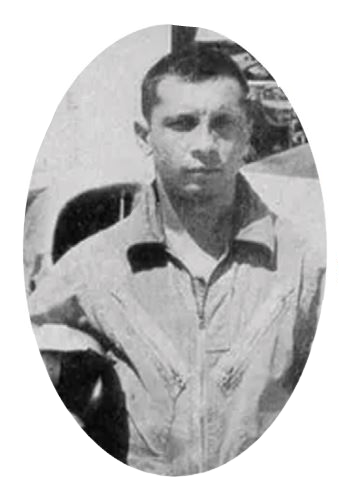Trevor Keelor was born on 8 December 1934 in Lucknow, Uttar Pradesh. He was educated at St Francis where his father was the principal. He had a brother, Denzil Keelor who was with him all through his years from school to the Air Force. He then attended the Le Martiniere College in Lucknow. As students of Le Martiniere, the Keelor brothers were known for their exploits in sports and the boxing ring. After school, he got commissioned in the Indian Air Force (IAF) as a fighter pilot along with his brother.
He took great interest in the maintenance and upkeep of aircraft. After training, Trevor Keelor as a young Pilot Officer joined the operational unit and soon became known for his bravery and exceptional flying skills. Later he got married to Patricia Ann Keelor and the couple had a son, Basil Keelor.
On 5 February 1964, Keelor, then Flight Lieutenant, was given the task to ferry a Gnat from Poona to Palam (Delhi) in a formation of five aircraft. The last part of the flight had to be undertaken at a height of 41,000 feet. When descending from 15,000 feet he realised there was no response to the throttle movements. Undeterred, he brought all his experience into play and managed a force-landing without damage to him or the aircraft. He was awarded, “Vayu Sena Medal (VM)” for his competence, courage and devotion to dutyHe took great interest in the maintenance and upkeep of aircraft. After training, Trevor Keelor as a young Pilot Officer joined the operational unit and soon became known for his bravery and exceptional flying skills. Later he got married to Patricia Ann Keelor and the couple had a son, Basil Keelor.
There were a series of skirmishes between India and Pakistan along the J&K border between April and September 1965. As tensions with Pakistan escalated in August 1965, the IAF alerted and moved to their operational locations. The Indian Air Force sent 45 Squadron’s de Havilland.
Vampires to support the Army but on the evening of 1 September, a Pakistani squadron of F-86 Sabres shot down three Vampires. A large part of IAF aircraft remained locked up in the East and did not take part in the operations for apprehension of Chinese intervention.
On 3 September morning, Indian radars picked up a Pakistani air patrol at Chhamb. The IAF had learnt that some Pakistani fighter planes were encircling the position of the Indian army. Consequently 23 Squadron was tasked to neutralise the threat. Squadron Leader (Sq Ldr) Jimmy Goodman flew a decoy of Mystere aircraft headed for the Chhamb sector the hotbed of battle especially for the armies. Escorting the Mysteres were 8 Gnat aircraft.
The Pakistani radar tracked the Mysteres taking he bait, directed their own fighters (Sabres and Starfighters) towards the Indian fighters. What the radar failed to track however, was a four Gnat formation trailing the Mysteres and another four Gnats behind the first Gnat formation. The second 4 aircraft Gnat formation was led by Trevor. The Gnats were not so sensitive to radars, so they remained unseen till two Sabres got caught in the formation. Unmindful of the numerical superiority of the enemy, Sq Ldr Trevor Keelor chased a Sabre jet and pressed home his attack until the enemy aircraft disintegrated in the air. This was the first victory of Air Force in the battle against Pakistani Air Force. Sq Ldr Keelor displayed courage and leadership of a high order in the best traditions of the Air Force.
This was a big morale booster for the IAF and also gave a big strategic advantage to India. Sq Ldr Trevor Keelor became an instant hero and was showered with accolades. He was given the “Vir Chakra” for his courage, professional skill and leadership. His elder brother, Denzil Keelor was also given the “Vir Chakra” for shooting down a Pakistani F 86. The two brothers were referred to as F86 slayers. Sq Ldr Trevor Keelor retired in 1968 after a glittering career. He died on 27 April 2002 leaving behind a rich legacy of service to the nation.

